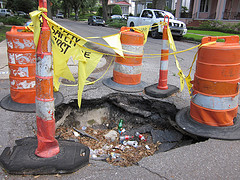 That harsh winter that hit parts of the U.S. is months gone, but it left something for drivers: potholes.
That harsh winter that hit parts of the U.S. is months gone, but it left something for drivers: potholes.
In April, a New York Times article named the winter “onslaught this year” as the reason for “pockmarked lunar landscapes rarely seen” in the Empire State.
If you’re an unfortunate motorist who’s driven into one of those pockmarks/potholes, you could be looking at bills for new tires, rims, an insurance deductible, and more.
But you’re not alone. It’s a familiar issue this time of year for drivers from Michigan to Pennsylvania to New Jersey.
A Coverage Walkthrough
Typically, you’ll address pothole-related vehicle damage with the collision coverage portion of your auto insurance policy.
Collision is an optional purchase. About 7 out of every 10 drivers in the U.S. buy collision coverage, according to the Insurance Information Institute (III).
However, many policies with collision coverage don’t specifically cover vehicle tires, which commonly are the vehicle parts that need replacing after pothole damage. So read your policy documents to know exactly what your collision protection covers.
A Deductibles Walkthrough
Whether or not you should file a car insurance claim for pothole-related damage depends on the damage itself.
Here’s a tip: If the cost to repair your car or replace vehicle parts is less than your auto policy deductible, you consider not filing a claim with your insurer. It’s a better deal for you.
So say that you’ve hit a pothole and sustained damage to your car. The damage: your tire and its rim need replacing.
The price tag for replacements: $300. Your deductible: $600.
So it’s better to pay out-of-pocket for those replacements than to pay your auto claim deductible’s higher price tag (which might also jack up your rates, since most insurers will inflate policy prices on you if you file a claim).
Also something to consider: drivers can sometimes seek money from claims programs.
According to New Jersey-based car insurer Plymouth Rock Assurance, some drivers can file a pothole damage claim with the New Jersey Department of the Treasury (NJDT). Claims must be submitted within 90 days of the accident. The NJDT can be reached at 609-292-4347.
According to the Times, New York operates a state reimbursement program for pothole damage on highways. However, the state only honors claims for damage occurring within a 6-month window between May and November.
State-to-state, these programs have different names and are handled in different departments, so check with your insurance regulator to see how you can file property damage claims with your state.
Insurance Tips
Online Auto Insurance has an FAQ on pothole-related damage with answers to questions including what you should do when a pothole causes you to crash and what to expect when pothole-related damages occur to custom car parts.
The III also has some pointers for you when using your auto insurance coverage to deal with pothole-related damage.
Driving Tips
Plymouth Rock Assurance issued its advisory about potholes this week after the insurer found sizable increases in claims about pothole damage. Potholes become especially common after winter because they are created in asphalt that is soaked by wintertime rain or snow, then crack under heat in following seasons.
According to Plymouth Rock, the number of claims jumped 72 percent between the winters of 2012-13 and 2013-14.
In that period, there was a 62 percent increase in the ratio of pothole-related claims, compared with all of Plymouth Rock’s collision claims.
The spikes are the likely result of severe wintertime snowy and icy conditions that hit the Garden State months ago, according to the insurer’s claims adjusters.
Plymouth Rock issued the following driving tips:
Photo Courtesy of Infrogmation of New Orleans